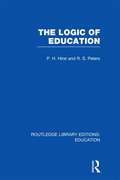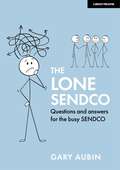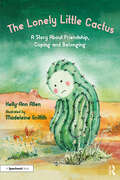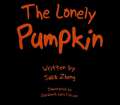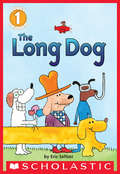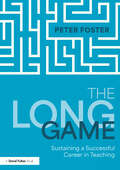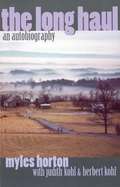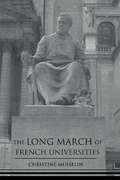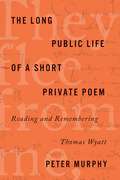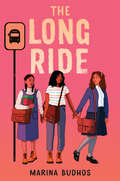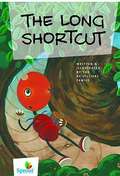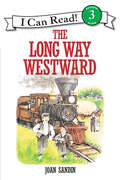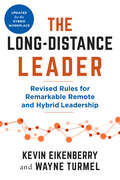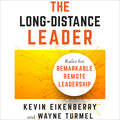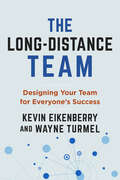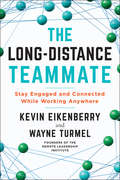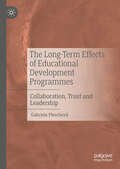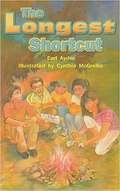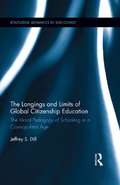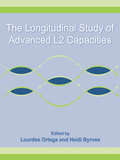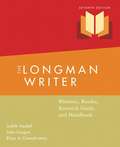- Table View
- List View
The Logic of Education (Routledge Library Editions: Education)
by P. H. Hirst and R. S. PetersThis book explores the implications for the curriculum, for teaching and for the authority structure of schools and colleges of an analysis of ‘education’ in which the development of knowledge and understanding is accorded a central position. The book explains what philosophy of education is, and by concentrating on its central concepts, initiates readers into exploring it for themselves. It also serves as a succinct introduction to the growing literature on philosophy of education in the UK.
The Lone SENDCO: Questions and answers for the busy SENDCO
by Gary AubinThe SENDCO role can feel quite isolating. SENDCOs know more than anyone in their setting about SEND, so who do they go to when they need support? Especially when new to the role, who do you turn to when tackling a problem or looking for inspiration? The Lone SENDCO answers over 300 questions that SENDCOs grapple with, whether experienced or new: How should outcomes be worded? Do I get longer to respond if I receive a consultation in the holidays? How shall I structure my inclusion department? How do I assess SEND for a child with EAL? How should I be working with my school’s Careers Officer? How do I motivate disengaged learners? What do Ofsted look for in an inspection?Split helpfully into easily-workable sections, this reference book can be picked up and dipped into, whatever the priority. Whether it’s organising an annual review for the first time, taking your partnership with parents to the next level or linking your work in SEND to cognitive science, The Lone SENDCO tackles the questions you have and the answers you need.Sections include: EHCPs and annual reviews, working with parents/carers, statutory compliance and legislation, strategic thinking as a SENDCO, identification and assessment of SEND, supporting transition for pupils, working with pupils, Ofsted developing my knowledge as a SENDCO, funding for SEND, teaching and learning, exam access arrangements, understanding data, tracking progress, managing a SEND register, understanding the SENDCO role, challenging decisions around placement and provision, CPD as a SENDCO, SEND as a whole-school issue, working with TAs, working with external partners, provision mapping, interventions, troubleshooting and a guide to types of need.
The Lone SENDCO: Questions and answers for the busy SENDCO
by Gary AubinThe SENDCO role can feel quite isolating. SENDCOs know more than anyone in their setting about SEND, so who do they go to when they need support? Especially when new to the role, who do you turn to when tackling a problem or looking for inspiration? The Lone SENDCO answers over 300 questions that SENDCOs grapple with, whether experienced or new: How should outcomes be worded? Do I get longer to respond if I receive a consultation in the holidays? How shall I structure my inclusion department? How do I assess SEND for a child with EAL? How should I be working with my school’s Careers Officer? How do I motivate disengaged learners? What do Ofsted look for in an inspection?Split helpfully into easily-workable sections, this reference book can be picked up and dipped into, whatever the priority. Whether it’s organising an annual review for the first time, taking your partnership with parents to the next level or linking your work in SEND to cognitive science, The Lone SENDCO tackles the questions you have and the answers you need.Sections include: EHCPs and annual reviews, working with parents/carers, statutory compliance and legislation, strategic thinking as a SENDCO, identification and assessment of SEND, supporting transition for pupils, working with pupils, Ofsted developing my knowledge as a SENDCO, funding for SEND, teaching and learning, exam access arrangements, understanding data, tracking progress, managing a SEND register, understanding the SENDCO role, challenging decisions around placement and provision, CPD as a SENDCO, SEND as a whole-school issue, working with TAs, working with external partners, provision mapping, interventions, troubleshooting and a guide to types of need.
The Lonely Little Cactus: A Story About Friendship, Coping and Belonging (Building Belonging and PlayWorlds for Wellbeing)
by Kelly-Ann AllenFor effective use, this book should be purchased alongside the activity book, Conceptual PlayWorlds for Wellbeing: A Resource Book for the Lonely Little Cactus. Both books can be purchased together as a set, Building Conceptual PlayWorlds for Wellbeing: The Lonely Little Cactus Story Book and Accompanying Resource Book. The Lonely Little Cactus is a children’s picture story book about a cactus that feels lonely living in the desert. Through a series of colourful interactions with desert dwellers, the little cactus learns strategies to cope with feelings of loneliness. Both entertaining and educational, the story book is aimed at children aged 4-8 years old and spreads the message that loneliness is a common emotion that is manageable and can be overcome. It teaches children an array of coping strategies and encourages them to try various approaches to managing a difficult situation to find the strategies that best work for them. Offering a unique opportunity for children to learn about psychological strategies while being engaged in a beautiful narrative and visually captivating illustrations, this is the ideal resource for educators, support staff, practitioners and parents looking to help children understand and manage their feelings.
The Lonely Little Cactus: A Story About Friendship, Coping and Belonging (The Lonely Little Cactus: A Storybook and Guide to Build Belonging in Children)
by Kelly-Ann AllenFor effective use, this book should be purchased alongside the activity book, Conceptual PlayWorlds for Wellbeing: A Resource Book for the Lonely Little Cactus. Both books can be purchased together as a set, Building Conceptual PlayWorlds for Wellbeing: The Lonely Little Cactus Story Book and Accompanying Resource Book.The Lonely Little Cactus is a children’s picture story book about a cactus that feels lonely living in the desert. Through a series of colourful interactions with desert dwellers, the little cactus learns strategies to cope with their feelings of loneliness. Both entertaining and educational, the story book is aimed at children aged 4–8 years old and spreads the message that loneliness is a common emotion that is manageable and can be overcome. It teaches children an array of coping strategies and encourages them to try various approaches to managing a difficult situation to find the strategies that best work for them. Offering a unique opportunity for children to learn about psychological strategies while being engaged in a beautiful narrative and visually captivating illustrations, this is the ideal resource for educators, support staff, practitioners and parents looking to help children understand and manage their feelings.
The Lonely Pumpkin
by Julia ZhengA sweet pumpkin gets picked up from the farm and carved into a scary jack-o'-lantern for trick or treating. The night before Halloween, he comes alive and decides to look for a friend. However, everyone he meets along the way judges him by his appearance and refuses to be his friend. Will there be someone who will accept the way the pumpkin is and be willing to befriend him? Find out in the book The Lonely Pumpkin.
The Long Dog (Scholastic Reader, Level 1)
by Eric SeltzerSimple text paired with large, toothy dog grins make this book a surefire hit with beginning readers!This level 1 reader uses funny dogs to introduce opposite words. There's a dirty dog and a clean dog, a mean dog and a nice dog, and many more! Plus, there's an extremely long dog who keeps popping into the story. The long dog adds humor to the book, and kids will be anxious to turn the pages all the way to the end! Young readers will enjoy Eric Seltzer's bright illustrations and rhythmic, easy-to-read text.
The Long Game: Sustaining a Successful Career in Teaching
by Peter FosterWhy do some teachers stay in teaching? And why do others leave? Why do some enjoy it whilst others find it an unrelenting slog? Answers to these questions are elusive but vital for new teachers, school leaders and everyone in between. Using research from wide-ranging fields and experience from real teachers, The Long Game examines how teachers can sustain and enjoy successful careers in teaching. Divided into five parts, the book explores the persistent challenges of being a teacher by breaking them down into problems and solutions. The chapters unpack the factors that get in the way of our success or enjoyment of teaching and considers the different ways these problems can be tackled, addressing key concerns, including: How to maintain motivation as you juggle work and life How to manage intensity in a non-stop job How to embed effective, long-lasting habits to save time and mental effort How to reduce workload not just ‘manage’ it How to teach successfully and have impact in a way that lasts Teaching isn’t like a game because it is frivolous or simple. But it is an infinitely layered problem we can spend our careers trying to solve. To sustain a successful and enjoyable career in teaching, we need to embed strategies and approaches that will minimise the challenges and maximise our enjoyment. The Long Game will help teachers to hold onto the joy in teaching by facing the challenges head on.
The Long Haul: an Autobiography
by Herbert Kohl Judith Kohl Myles HortonIn his own direct, modest, plain-spoken style, Myles Horton tells the story of the Highlander Folk School. A major catalyst for social change in the United States for more than sixty years, this school has touched the lives of so many people, Martin Luther King, Jr., Rosa Parks, Eleanor Roosevelt, and Pete Seeger. Filled with disarmingly honest insight and gentle humor, The Long Haul is an inspiring hymn to the possibility of social change. It is the story of Myles Horton, in his own words: the wise and moving recollections of a man of uncommon determination and dignity. [From the Book Jacket]
The Long March of French Universities
by Christine MusselinThe main point of this book is to argue that French universities experienced a quiet but important change during the last decade, which allowed them to become pertinent and more autonomous actors within the French university system.
The Long Public Life of a Short Private Poem: Reading and Remembering Thomas Wyatt (Square One: First-Order Questions in the Humanities)
by Peter MurphyThomas Wyatt didn't publish "They Flee from Me." It was written in a notebook, maybe abroad, maybe even in prison. Today it is in every poetry anthology. How did it survive? That is the story Peter Murphy tells—in vivid and compelling detail—of the accidents of fate that kept a great poem alive across 500 turbulent years. Wyatt's poem becomes an occasion to ask and answer numerous questions about literature, culture, and history. Itself about the passage of time, it allows us to consider why anyone would write such a thing in the first place, and why anyone would care to read or remember the person who wrote it. From the deadly, fascinating circles of Henry VIII's court to the contemporary classroom, The Long Public Life of a Short Private Poem also introduces us to a series of worlds. We meet antiquaries, editors, publishers, anthologizers, and critics whose own life stories beckon. And we learn how the poem came to be considered, after many centuries of neglect, a model of the "best" English has to offer and an ideal object of literary study. The result is an exploration of literature in the fine grain of the everyday and its needs: in the classroom, in society, and in the life of nations.
The Long Ride
by Marina BudhosIn the tumult of 1970s New York City, seventh graders are bussed from their neighborhood in Queens to integrate a new school in South Jamaica. <P><P>Jamila Clarke. Josie Rivera. Francesca George. Three mixed-race girls, close friends whose immigrant parents worked hard to settle their families in a neighborhood with the best schools. The three girls are outsiders there, but they have each other. <P><P>Now, at the start seventh grade, they are told they will be part of an experiment, taking a long bus ride to a brand-new school built to "mix up the black and white kids." Their parents don't want them to be experiments. Francesca's send her to a private school, leaving Jamila and Josie to take the bus ride without her. <P><P>While Francesca is testing her limits, Josie and Jamila find themselves outsiders again at the new school. As the year goes on, the Spanish girls welcome Josie, while Jamila develops a tender friendship with a boy--but it's a relationship that can exist only at school.
The Long Shortcut
by The De Villiers FamilyWhat’s a Friend to Do?Sprout and Twig are late for school, so Twig ignores their teacher’s instructions and takes a shortcut. When his friend doesn’t show up in time for class, Sprout lies to their teacher about what happened. But as time passes and Twig still doesn’t come, Sprout grows worried. Should he tell the truth, even if it means his friend will get in trouble for disobeying?This lively adventure teaches children ages 4 to 7 the importance of always telling the truth and helps them remember that rules are made for a reason.Seeds of Faith for a Lifetime of Growth The earliest years of childhood provide fertile soil for seeds of faith, and the captivating Seedling and Sprout series offers the perfect way to introduce toddlers and preschoolers to the God who created their wonder-filled world. Each book is artfully designed with vibrant, contemporary illustrations and communicates vital truths that nurture young faith.
The Long Way Westward
by Joan SandinAmerica, at last! This classic early reader tells an exciting story and is also a good launching pad for classroom and home discussions.The Long Way Westward relates the experiences of two young brothers and their family, immigrants from Sweden, from their arrival in New York through the journey to their new home in Minnesota.This lively sequel to The Long Way to a New Land follows the fortunes of Carl Erik’s family from New York City to the farmlands of Minnesota. "Historically accurate; will attract competent primary-grade readers and will be equally suitable for less able readers in intermediate grades." (School Library Journal)As a fan of this book and its companion, The Long Way to a New Land, put it: "The books describe the difficulty and dangers of the journey in a way that is non-complaining and full of optimism for a new life in America. Teachers, these books are wonderful for integrating with other subjects and topics, such as immigration, westward expansion, steamships, trains, geography, and American life in the 1860s."Author-artist Joan Sandin's grandfather was born in Sweden and immigrated to Wisconsin with his parents in 1882, when he was only two. Joan herself spent time in Sweden and did extensive research to create her well-loved classic books about the immigrant experience.
The Long-Distance Leader, Second Edition: Revised Rules for Remarkable Remote and Hybrid Leadership (The Long-Distance Worklife Series)
by Kevin Eikenberry Wayne TurmelThe new edition of this internationally acclaimed guide to remote and hybrid leadership comes with an updated and enriched framework for the modern workplace. It introduces new principles and retains proven strategies for effective leadership across distances.When The Long-Distance Leader was first published, it was pre-pandemic and remote work was in its infancy with 30% of managers leading at a distance—now that number is well over 50%.As more organizations adopt a remote workforce, the challenges of leading at a distance become more urgent than ever. The cofounders of the Remote Leadership Institute, Kevin Eikenberry and Wayne Turmel, show leaders how to guide their teams by recalling the foundational principles of leadership whether their teams are remote, hybrid, co-working, or something entirely new!The authors' "Three-O" Model refocuses leaders to think about outcomes, others, and ourselves—elements of leadership that remain unchanged, whether employees are down the hall or halfway around the world. By pairing it with the Remote Leadership Model, which emphasizes using technology as a tool and not a distraction, leaders can navigate the terrain of managing teams wherever they are.This second edition features updated exercises that ensure projects stay on track, keep productivity and morale high, and build lasting relationships, along with a new chapter on hybrid workplaces.
The Long-Distance Leader: Rules for Remarkable Remote Leadership
by Kevin Eikenberry Wayne TurmelLeadership first, location secondAs more organizations adopt a remote workforce, the challenges of leading at a distance become more urgent than ever. The cofounders of the Remote Leadership Institute, Kevin Eikenberry and Wayne Turmel, show leaders how to guide their teams by recalling the foundational principles of leadership. The authors' &“Three-O&” Model refocuses leaders to think about outcomes, others, and ourselves—elements of leadership that remain unchanged, whether employees are down the hall or halfway around the world. By pairing it with the Remote Leadership Model, which emphasizes using technology as a tool and not a distraction, leaders are now able to navigate the terrain of managing teams wherever they are. Filled with exercises that ensure projects stay on track, keep productivity and morale high, and build lasting relationships, this bookis the go-to guide for leading, no matter where people work.
The Long-Distance Team: Designing Your Team for Everyone's Success (The Long-Distance Worklife Series)
by Kevin Eikenberry Wayne TurmelDesign and cultivate remote work teams that actually work.From the experts who brought you The Long-Distance Leader and The Long-Distance Teammate comes the proven and practical guide for leaders to consciously design teams, define and create their desired culture, and encourage and nurture employee engagement-all from a distance. Team design and culture are often presented as separate concepts when they are in fact intertwined in the remote work setting. Using the 3C model of communication, collaboration, and cohesion, leaders will be given the tools to overcome challenges, such as proximity bias and deteriorating social connections, to create an environment where everyone can contribute and add value equally, regardless of location. The 3Cs are Communication-While communication is a fundamental part of being human, it is also a critical foundation of successful work. Without it, teams break down. Collaboration-Remote leaders face the misguided belief that physical presence is required to have a collaborative team. The truth is that proximity has nothing to do with successful collaboration. Cohesion-This dimension includes decidedly nonstructural aspects, such as relationships, trust, and accountability. While difficult to measure, a team's cohesion is critical to its success. Using this framework, leaders of all levels will learn to assess, design, and develop their communication channels, methods for remote collaboration, and ability to foster cohesion to build successful long-distance teams. While a hybrid culture will be different, it can, when done right, be better than what existed before.
The Long-Distance Teammate: Stay Engaged and Connected While Working Anywhere (The Long-Distance Worklife Series)
by Kevin Eikenberry Wayne TurmelWhat does it mean to "go to work" when you don't actually leave the house? This is the ultimate guide for remote workers who want to stay engaged as team members, maintain robust work relationships, and keep an eye on their long-term career goals. Even before the coronavirus hit, remote work was growing at nearly 30 percent per year, and now it's just a fact of life. There are many millions of people who once worked at a central location every day who now find themselves facing an entirely new way of working. Written by the founders of the Remote Leadership Institute, this book is the most authoritative single resource for helping remote workers get work done effectively, build relationships that are both productive and satisfying, and maintain a career trajectory when they are not in constant close contact with their leader, coworkers, or the organization in general.The Long-Distance Teammate tackles three important issues: navigating the personal and interpersonal, growing the skills to be productive, and communicating effectively—all from a distance. In short, there is a big difference between working at home and being an effective member of a team. This practical guide describes that difference and allows you to be a great remote teammate.
The Long-Term Effects of Educational Development Programmes: Collaboration, Trust and Leadership
by Gabriela PleschováThis book investigates the long-term effects of educational development (ED) programmes on teaching perceptions and practices. The research draws comparisons between an ED programme at a university in the United Kingdom dedicated to advancing teaching, an international university where high-quality education is central to its mission, and two universities in Central and Eastern Europe with an ambition to rise in rankings and attract international students. It examines collaboration, trusting relationships and leadership as key drivers of effective practices. The book is a valuable resource for researchers, educational developers and higher education leaders .
The Longest Night
by Jacqueline Guest Alan MarksWind Runner must complete his Vision Quest if he is to fulfill his dream of becoming a great warrior. He will need to learn the true value of trust and loyalty - how else will he survive for three long nights, alone on the mountain?
The Longings and Limits of Global Citizenship Education: The Moral Pedagogy of Schooling in a Cosmopolitan Age (Routledge Advances in Sociology #109)
by Jeffrey S. DillAs the world seemingly gets smaller and smaller, schools around the globe are focusing their attention on expanding the consciousness and competencies of their students to prepare them for the conditions of globalization. Global citizenship education is rapidly growing in popularity because it captures the longings of so many—to help make a world of prosperity, universal benevolence, and human rights in the midst of globalization’s varied processes of change. This book offers an empirical account from the perspective of teachers and classrooms, based on a qualitative study of ten secondary schools in the United States and Asia that explicitly focus on making global citizens. Global citizenship in these schools has two main elements, both global competencies (economic skills) and global consciousness (ethical orientations) that proponents hope will bring global prosperity and peace. However, many of the moral assumptions of global citizenship education are more complex and contradict these goals, and are just as likely to have the unintended consequence of reinforcing a more particular Western individualism. While not arguing against global citizenship education per se, the book argues that in its current forms it has significant limits that proponents have not yet acknowledged, which may very well undermine it in the long run.
The Longitudinal Study of Advanced L2 Capacities (Second Language Acquisition Research Series)
by Lourdes Ortega Heidi ByrnesResearchers and educators routinely call for longitudinal research on language learning and teaching. The present volume explores the connection between longitudinal study and advanced language capacities, two under-researched areas, and proposes an agenda for future research. Five chapters probe theoretical and methodological reflections about the longitudinal study of advanced L2 capacities, followed by eight chapters that report on empirical longitudinal investigations spanning descriptive, quasi-experimental, qualitative, and quantitative longitudinal methodologies. In addition, the co-editors offer a detailed introduction to the volume and a coda chapter in which they explore what it would take to design systematic research programs for the longitudinal investigation of advanced L2 capacities. The scholars in this volume collectively make the argument that second language acquisition research will be the richer, theoretically and empirically, if a trajectory toward advancedness is part of its conceptualization right from the beginning and, in reverse, that advancedness is a particularly interesting acquisitional level at which to probe contemporary theories associated with the longitudinal study of language development. Acknowledging that advancedness is increasingly important in our multicultural societies and globalized world, the central question explored in the present collection is: How does learning over time evolve toward advanced capacities in a second language?
The Longman Guide To Writing Center Theory And Practice
by Robert Barnett Jacob BlumnerThe Longman Guide to Writing Center Theory and Practice offers, in unparalleled breadth and depth, the major scholarship on writing centers. This up-to-date resource for students, instructors, and scholars anthologizes essays on all major areas of interest to writing center theorists and practitioners. Seven sections provide a comprehensive view of writing centers: history, progress, theorizing the writing center, defining the writing center's place, writing-across-the curriculum, the practice of tutoring, cultural issues, and technology.
The Longman Writer: Rhetoric, Reader, Research Guide, and Handbook (7th edition)
by John Langan Judith Nadell Eliza A. ComodromosClear, step-by-step writing instruction, ample annotated student essays, and extensive practice opportunities for writing have made The Longman Writer one of the most successful methods-of-development guides for college writing. Created by the authors of the best-selling Longman Reader, the text draws on decades of teaching experience to integrate the best of the "product" and "process" approaches to writing. Its particular strengths include an emphasis on the reading-writing connection, a focus on invention and revision, attention to the fact that patterns blend in actual writing, and an abundance of class-tested activities and assignments--more than 350 in all.
